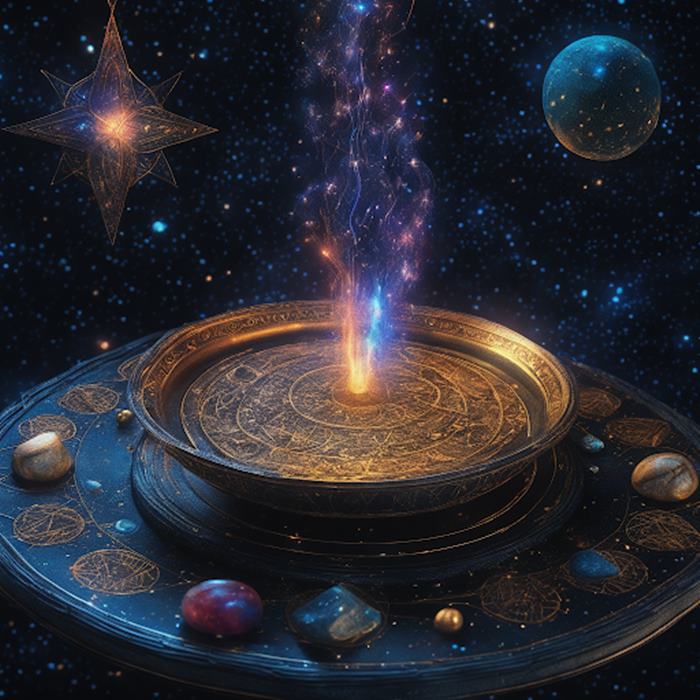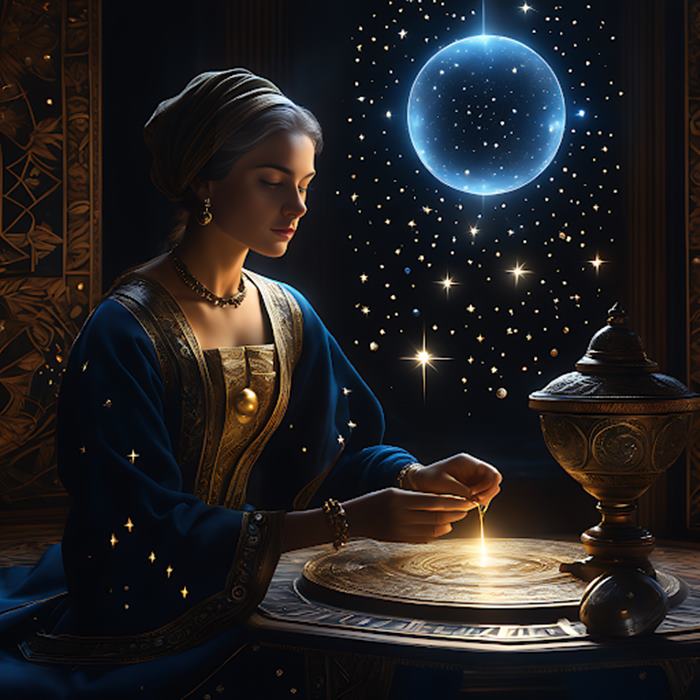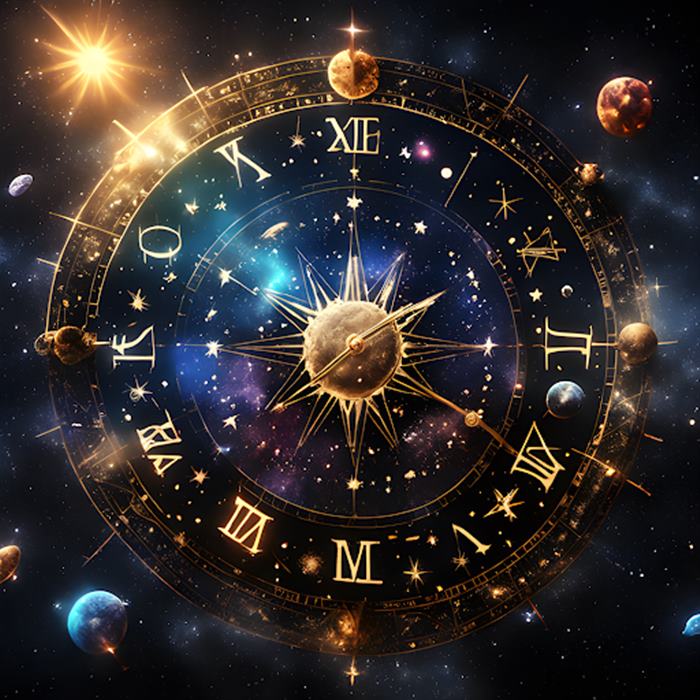- What is Horary Astrology? Unveiling the Mysteries of an Ancient Divinatory Practice
- Defining the Practice of Horary Astrology
- The Mechanics of Horary Astrology
- Origins and History of Horary Astrology
- Horary Astrology in Ancient Cultures
- Revival and Modern Usage
- How Does Horary Astrology Work?
- Casting the Chart
- Interpreting the Placements
- The Role of Planets
- Significators and Houses
- Aspects and Configurations
- Time-Sensitivity in Horary Astrology
- Common Questions Addressed
- Accuracy and Reliability
- Criticism and Skepticism
- Historical Context
- Modern Applications
- Ethical Considerations
- Cultural Variations
- When Was Horary Astrology Developed — And Can You Practice It Yourself?
- Ancient Origins of Horary Astrology
- Practicing Horary Astrology as a Beginner
- What Questions Can Horary Astrology Answer?
- Relationships and Love
- Career and Finance
- How To Read A Horary Astrology Chart: Understanding House Cusps and Aspect Configurations
- The Importance of House Cusps
- Understanding the Astrological Houses
- Significance of House Cusps in Horary Astrology
- Interpreting Aspect Configurations
- Major Aspects: Conjunction, Opposition, Trine, Square, and Sextile
- Minor Aspects: Quincunx and Semi-Sextile
- Blending House Cusps and Aspect Configurations
- Practical Example: A Horary Astrology Chart Reading
- Tips for Beginners in Horary Astrology
- Horary Astrology: The Theory and Practice of Finding Lost Objects
- Significators for People and Objects
- Interpretation Techniques
- How Accurate is Horary Astrology? Unveiling the Skepticism, Testimonials, and Successes
- Skepticism and Critiques
- The Scientific Lens
- Coincidence or Causation?
- Lack of Empirical Evidence
- Testimonials and Successes
- Case Studies and Remarkable Predictions
- Personal Anecdotes and Believer’s Perspective
- Cultural and Historical Significance
- Horary Astrology Tips & Tricks: Mastering Effective Questioning and Chart Rectification
- Asking Effective Questions
- The Art of Chart Rectification
- Unveiling Insights Through Planetary Interactions
- Utilizing Houses for Clarity
- Analyzing Aspects: Unraveling Celestial Conversations
- Stellar Time: Determining the Right Moment
- The Intricacies of Planetary Dignities and Debilities
- Transits and Timing: Navigating Life’s Crossroads
- Rectification: Aligning Life Events and Celestial Patterns
- Fine-Tuning Your Chart: Progressions and Directions
- The Role of Intuition in Horary Astrology
- Empowering Decision-Making with Cosmic Insights
- The Planets in Horary: Unveiling the Influence of Personal and Outer Planets
- 1. Personal Planets
- The Illuminating Sun
- The Reflective Moon
- The Analytical Mercury
- The Harmonious Venus
- 2. Outer Planets
- The Expansive Jupiter
- The Disciplined Saturn
- The Revolutionary Uranus
- The Mysterious Neptune
- The Transformative Pluto
- Planetary Signification in Horary Astrology
- 1. Determining Significators
- The Role of Planetary Significators
- Traditional Planetary Rulerships
- Accidental Significators
- 2. Analyzing Significator Interactions
- Aspects and Relationships
- Combustion and Cazimi
- Retrogradation
- Mutual Reception and Combust Planets in Horary Astrology
- 1. Identifying Mutual Reception
- 1.1 Significance of Mutual Reception
- 1.2 Effects of Mutual Reception
- 2. The Effects of Combustion
- 2.1 The Impact on Planetary Energies
- 2.2 Navigating Combustion
- Timing in Horary Astrology: Unveiling the Significance
- Transits and Progressions
- Understanding Direct Motion
- Exploring Retrograde Motion
- The Interplay of Planetary Movements
- The Influence on Horary Astrology
- Significance in Personal Readings
- Ancient Wisdom and Modern Interpretations
- Timing and Decision-Making
- Navigating Challenges with Timing
- Synchronicity and Alignment
- Harnessing Favorable Timelines
- Cautions and Considerations
- Case Studies: Timing Accuracy
- Consulting a Horary Astrologer: Insights and Expectations
- Finding a Qualified Astrologer
- Researching Credentials and Expertise
- Reading Client Testimonials
- Seeking Recommendations
- Verifying Ethical Practices
- What to Expect in a Session
- Providing Birth Details
- Asking the Question
- Analyzing the Astrological Chart
- Explaining Symbolism and Interpretations
- Offering Insights and Guidance
- Fresh Perspectives with Horary Astrology: Gaining New Insights
- Horary vs. Natal Astrology
- Understanding Horary Astrology
- The Foundations of Natal Astrology
- The Approach to Chart Interpretation
- Time-Sensitive Queries in Horary Astrology
- The Role of Planetary Positions
- Personal Questions and Horary Astrology
- Natal Birth Charts: A Snapshot of a Life
- Gaining Insights into Personality Traits
- Predictive Aspects of Natal Astrology
- The Influence of Planetary Transits
- Answering Specific Questions with Horary Astrology
- The Intricacies of Planetary Aspects
- Holistic Life View in Natal Astrology
- Fresh Perspectives and Clarity with Horary Astrology
- Horary Astrology in the Modern World: Unlocking Insights for Contemporary Seekers
- 1. Contemporary Perspectives
- 1.1 The Digital Revolution and Horary Astrology
- 1.2 Horary Astrology as a Tool for Decision-Making
- 1.3 Addressing Contemporary Concerns
- 2. Benefits for Seekers
- 2.1 Immediate Answers to Specific Questions
- 2.2 Validation and Assurance
- 2.3 A Personalized Approach to Guidance
- 2.4 A Bridge Between Intuition and Logic
- 2.5 Gaining Clarity in a Complex World
- Conclusion: Key Takeaways on Horary Astrology and Its Role in Providing Guidance
- FAQs
- Q: What is horary astrology?
- Q: How does horary astrology work?
- Q: What types of questions can be answered using horary astrology?
- Q: How is a horary chart created?
- Q: What are planetary significators in horary astrology?
- Q: What is the significance of retrograde planets in horary astrology?
- Q: How can horary astrology help in making decisions?
- Q: What is the importance of houses in horary astrology?
- Q: How does horary astrology determine who is represented by each house ruling planet?
- Q: What is the importance of applying aspects in horary astrology?
Horary astrology is a fascinating branch of astrology that focuses on answering specific questions posed by individuals. Instead of analyzing a person’s natal chart, horary astrology creates a separate chart based on the moment the question is asked. This horary chart, also known as a question chart, provides valuable insights into the specific issue at hand.
In horary astrology, the person asking the question is represented by the seventh house. For instance, if a person born under the zodiac sign Libra asks a question, their ascendant would be in Libra, placing Aries in the seventh house. Similarly, someone with Scorpio rising would have Taurus in the seventh house, and so on.
Traditional astrology uses different house systems to judge the horary chart. However, one of the most commonly used systems in horary astrology is the whole sign house system. This means that each house represents an entire sign, eliminating the need to calculate house cusps. In this system, the first house always represents the person asking the question.

When judging a horary chart, there are several important factors to consider. One is the presence of malefic planets in certain positions, such as the Via Combusta or Void-of-Course Moon. These placements suggest that the question being asked may not be appropriate or that the person may not be thinking clearly about the issue.
Horary astrology can answer a wide range of questions, as long as they are specific and clear. Common questions include matters of love and relationships, career decisions, and even finding lost objects or pets. Each of the 12 houses in a horary chart represents a different area of life and can provide insights into various aspects of the question at hand.
One important aspect to consider in horary astrology is the mutual reception of the planetary significators. If the significators are in mutual reception, it suggests that the chart is fit for judging and that the answer to the question is likely to be accurate. On the other hand, if the significators are not in mutual reception, it is believed that the chart may be biased or unreliable.
The ruler of the ascendant, or the planet that rules the sign on the cusp of the first house, plays a crucial role in interpreting a horary chart. Its position, aspects, and condition reveal important details about the person asking the question and the outcome of the situation.
Horary astrology is a complex and nuanced field, with its own set of rules and techniques. By analyzing the horary chart and considering the various factors and significators, astrologers can provide valuable insights and guidance to those seeking answers. Whether it’s finding clarity in a confusing situation or making important decisions, horary astrology offers a unique and powerful tool for understanding the mysteries of life.
What is Horary Astrology? Unveiling the Mysteries of an Ancient Divinatory Practice

In the vast realm of astrology, various branches offer unique insights into the mysteries of human existence and the cosmos. Horary astrology, often shrouded in mystique, stands as a divinatory practice that provides answers to specific questions by examining the positions of celestial bodies. Let’s delve into the essence of horary astrology, its origins, and its intriguing history.
Defining the Practice of Horary Astrology
Horary astrology is a specialized branch of astrology that focuses on providing answers to questions through the interpretation of celestial placements at the moment the question is posed. Instead of analyzing birth charts, horary astrologers cast a chart for the exact time and location when the question arises. This chart becomes a snapshot of the cosmic energies influencing the situation, offering insights and predictions.
The Mechanics of Horary Astrology
When seeking answers through horary astrology, the astrologer constructs a chart called a “horary chart.” This chart is erected for the time, date, and location of the question. The positions of planets, signs, and houses in the chart are then interpreted to derive meaningful insights. The astrologer considers planetary aspects, house placements, and planetary dignities to formulate accurate responses.
Origins and History of Horary Astrology
The roots of horary astrology can be traced back to ancient civilizations, where divination was intertwined with astrology. Babylonians, Egyptians, and Greeks all practiced forms of horary astrology, recognizing its power to reveal hidden truths and guide decision-making.
Horary Astrology in Ancient Cultures
- Babylonians: In Babylon, astrologers engaged in horary practices to address political matters, wars, and personal inquiries. They believed that the positions of celestial bodies held answers to significant questions.
- Egyptians: Egyptian priests practiced a form of horary astrology, linking celestial occurrences to events on Earth. Horary charts were used to predict the flooding of the Nile and other vital agricultural aspects.
- Greeks: Horary astrology gained prominence in ancient Greece, with prominent figures like Ptolemy and Dorotheus discussing its methodologies. It was utilized for inquiries ranging from medical concerns to weather predictions.
Revival and Modern Usage
After a period of relative obscurity, horary astrology experienced a revival during the Renaissance. It garnered attention from notable astrologers like William Lilly, who authored key works on the subject. Today, horary astrology remains a cherished practice among astrologers and seekers of divinatory guidance.
How Does Horary Astrology Work?
Horary astrology operates on the premise that the moment a question is posed provides a snapshot of the universe’s energy, which can be analyzed to gain insights into the query. This system is rooted in the belief that the positions and relationships of planets at the time of questioning can reveal hidden information about the situation.
Casting the Chart
To begin, a horary astrologer creates a chart for the exact moment when a question is asked. This chart, known as a horary chart, is a snapshot of the celestial positions at that precise time. The astrologer identifies the zodiac sign on the Ascendant, which represents the querent, and the positions of planets in relation to the twelve houses of the horoscope.
Interpreting the Placements
Once the horary chart is cast, the astrologer interprets the placements of planets in various houses and signs. Each planet symbolizes different aspects of life, and their positions provide clues to the answer. For instance, if the planet associated with communication is found in the house of partnerships, it might suggest a need for clear communication in a relationship.
The Role of Planets
In horary astrology, planets have distinct roles and meanings. The Moon, for instance, signifies emotions and fast-moving events, while Mercury represents communication and decision-making. The positions of these planets in relation to houses and signs help astrologers decipher the dynamics of the situation.
Significators and Houses
Certain houses in the horary chart are associated with specific areas of life, such as relationships, careers, and health. Planets become significators when they rule over or occupy these houses. Analyzing the interactions between significators can provide detailed insights into the question at hand.
Aspects and Configurations
Aspects are angular relationships between planets that can be harmonious or challenging. The angles formed to reveal the interactions between different forces in the querent’s life. Configurations, such as grand trines or T-squares, offer additional layers of information, deepening the astrologer’s understanding.
Time-Sensitivity in Horary Astrology
Timing is crucial in horary astrology. Each house represents a specific period of time, and the movement of planets within these houses indicates when events might unfold. Astrologers consider the movement of the Moon and other planets to estimate the timing of events or changes.
Common Questions Addressed
Horary astrology can provide insights into a wide range of questions, from relationship concerns to career decisions. Questions about love, finances, travel, and health can all be explored using this method.
Accuracy and Reliability
Critics and skeptics often question the accuracy of horary astrology, as interpretations can vary among practitioners. However, many experienced astrologers vouch for the effectiveness of this method when practiced diligently and with a deep understanding of astrological principles.
Read more: Kamasutra Astrology – Find Out Your Best Sex Position with yours zodiac sign compatibility
Criticism and Skepticism
As with any form of divination, horary astrology has its share of critics. Skeptics argue that the results could be coincidental or open to subjective interpretations. The lack of empirical evidence also contributes to skepticism around this practice.
Historical Context
Horary astrology has ancient roots and has been practiced for centuries across different cultures. Historical records show its prevalence in various civilizations, including ancient Greece and the Arab world.
Modern Applications
In today’s digital age, horary astrology has found its way into online forums and consultations. Modern practitioners often blend traditional techniques with contemporary insights, catering to a diverse range of clients seeking answers to their pressing questions.
Ethical Considerations
Ethical considerations play a role in horary astrology, especially when dealing with sensitive topics. Astrologers must balance their responsibility to provide valuable insights with the potential impact their interpretations might have on individuals’ lives.
Cultural Variations
Different cultures approach horary astrology with varying perspectives. Some cultures embrace it as a valuable tool for decision-making, while others view it as superstitious or unacceptable. Cultural context significantly influences how horary astrology is perceived and practiced.
When Was Horary Astrology Developed — And Can You Practice It Yourself?

Ancient Origins of Horary Astrology
- Early References
The earliest references to horary astrology can be traced back to ancient texts from Mesopotamia and Egypt. These cultures held a strong belief in the connection between celestial patterns and earthly events. Ancient astrologers would cast charts to answer questions about topics ranging from wars to weather conditions.
- Hellenistic Advancements
Horary astrology as we recognize it today began to take shape during the Hellenistic period. Scholars like Claudius Ptolemy contributed to the development of astrological techniques, including the casting of horary charts. During this time, astrology was closely intertwined with philosophy and science.
- Medieval and Renaissance Refinement
The Middle Ages and Renaissance witnessed further refinement of horary astrology. Scholars like William Lilly and Guido Bonatti made significant contributions to the practice. Horary charts became a tool for answering specific questions, ranging from personal matters to mundane events.
Practicing Horary Astrology as a Beginner
Horary astrology remains a captivating field that allows beginners to tap into its wisdom and guidance. Here’s how you can get started:
- Formulate Your Question
The first step in practicing horary astrology is to formulate a clear and specific question. The question should be something that can be answered with a simple “yes” or “no.” Focus on a topic that holds personal significance to you.
- Cast the Chart
Once you have your question, cast a horary chart for the moment you ask it. The positions of the planets and houses at that exact time provide insights into the answer. Numerous online tools and software are available to help you generate horary charts.
- Interpret the Chart
Interpreting a horary chart involves analyzing the positions of planets and houses in relation to your question. Each planet and house represents different aspects of the question. By examining their interactions, you can derive insights into the potential outcome.
- Consider Traditional Principles
Horary astrology relies on a set of traditional principles and rules that guide interpretations. Study these principles to understand how planets, houses, and aspects contribute to the answer. Remember that practice and experience enhance your interpretative skills.
- Trust Your Intuition
While horary astrology provides a structured framework, intuition also plays a role. As a beginner, trust your gut feelings and initial impressions. Over time, you’ll develop a deeper connection with the symbolism in the charts.
- Record and Reflect
Maintain a journal of your horary questions, charts, and outcomes. This practice helps you track your progress and learn from your experiences. Regularly revisit your past questions to gain insights into patterns and themes.
What Questions Can Horary Astrology Answer?

In the realm of astrology, horary astrology stands as a unique form of divination that delves into various aspects of life, offering insights and guidance through the intricate dance of the planets. Let’s explore how horary astrology can shed light on questions concerning relationships and love, as well as career and finance.
Relationships and Love
- Unveiling Matters of the Heart through Horary Astrology
Horary astrology provides a remarkable tool to delve into matters of the heart. By casting a horary chart at the moment when a question about relationships or love arises, astrologers can gain insights into the dynamics between individuals. This includes questions about potential romantic partners, the longevity of relationships, and the resolution of conflicts.
- Navigating Compatibility
Horary astrology excels in assessing compatibility between individuals. The positions of Venus and Mars in the chart can reveal the harmony or challenges present in a relationship. The aspects between these planets and others can indicate the level of attraction and communication between partners.
- Timing Matters
One of the most intriguing aspects of horary astrology is its ability to provide timing-related answers. Questions like “When will I meet my soulmate?” or “Is this the right time to confess my feelings?” find resolution through the movement of celestial bodies. Planetary transits and aspects can pinpoint auspicious moments for actions related to love and relationships.
Career and Finance
- Guiding Professional Trajectories with Horary Astrology
Horary astrology extends its reach into the professional realm, offering insights that can steer career decisions. When posed with career-related questions, the positions of planets such as Mercury, Jupiter, and Saturn hold significance in understanding the potential for success and challenges in one’s career path.
- Choosing the Right Path
Horary astrology can be a valuable tool when making career choices. Questions like “Should I change my job?” or “Is this the right career path for me?” can be explored through the chart’s indications. The positions of the Sun and Moon can shed light on the individual’s core strengths and passions.
- Financial Outlook
The financial landscape can also be illuminated through horary astrology. By analyzing the positions of planets associated with wealth, such as Jupiter and Venus, astrologers can offer insights into financial opportunities and potential setbacks. This includes questions about investments, windfalls, and stability.
How To Read A Horary Astrology Chart: Understanding House Cusps and Aspect Configurations

The Importance of House Cusps
Understanding the Astrological Houses
In horary astrology, the astrological chart is divided into twelve houses, each representing different areas of life. The house cusps, or the starting points of each house, play a significant role in understanding the question’s context. The houses are linked to various aspects of life, such as relationships, careers, health, and finance.
Significance of House Cusps in Horary Astrology
The house cusps are determined by the zodiac sign that appears on the cusp and the ruling planet of that sign. These factors provide insights into the energies influencing the question. For instance, if the cusp of the 7th house, which relates to relationships, falls in Leo, the Sun’s qualities of leadership and creativity may influence the question’s answer.
Interpreting Aspect Configurations
Major Aspects: Conjunction, Opposition, Trine, Square, and Sextile
Aspects are angular relationships between planets that reveal their interactions. Major aspects include conjunction (intense blending), opposition (tension), trine (harmony), square (challenge), and sextile (opportunity). These aspects bring unique dynamics to the chart and help the astrologer understand the complexity of the question.
Minor Aspects: Quincunx and Semi-Sextile
Minor aspects, like the quincunx and semi-sextile, add nuance to the interpretation. The quincunx creates a sense of unease, requiring adjustments, while the semi-sextile suggests subtle connections between planets. Integrating both major and minor aspects enhances the chart’s depth.
Blending House Cusps and Aspect Configurations
To read a horary astrology chart effectively, astrologers combine the meanings of house cusps and aspect configurations. For instance, if the 2nd house cusp (linked to finances) has a trine aspect with Jupiter (expansion), it could indicate positive financial growth.
Practical Example: A Horary Astrology Chart Reading
Let’s consider a question about a potential job change. By analyzing the house cusps and aspect configurations, an astrologer can provide insights into the timing, outcome, and potential challenges of the job change.
Tips for Beginners in Horary Astrology
- Start with Basics: Begin by understanding the significance of planets, signs, and houses in astrology.
- Practice Patience: Horary astrology requires meticulous analysis; take your time.
- Combine Intuition and Knowledge: Blend your intuitive insights with astrological knowledge.
- Keep Learning: Horary astrology is a lifelong learning journey; stay curious.
Horary Astrology: The Theory and Practice of Finding Lost Objects
Significators for People and Objects
In horary astrology, the cosmic dance of planets and stars is believed to mirror the events unfolding on Earth. When it comes to locating lost objects, astrologers assign signification to both the inquirer and the missing item. These significators act as celestial representatives, reflecting the unique energies associated with each.
- The Inquirer as a Significator
In the realm of lost and found, the seeker of an answer becomes a vital part of the equation. The astrologer identifies a planet or celestial body that corresponds to the inquirer’s astrological sign and chart placement. This selected significator is then examined in relation to other cosmic factors to unravel the story behind the missing object.
- The Missing Object as a Significator
Just as individuals possess astrological signatures, so do objects. An object’s nature, purpose, and the emotional connection it holds with the owner determine its astrological representation. By aligning the missing object’s significator with planetary movements, astrologers decode the potential locations and conditions surrounding the item.
Interpretation Techniques
Horary astrology relies on a rich tapestry of interpretation techniques to derive insights from the heavens. These methods empower astrologers to provide meaningful responses that guide seekers toward their lost possessions.
- Planetary Aspects and Configurations
The interplay between planets is the crux of horary astrology. Astrologers analyze the angles formed between the signification and other celestial bodies, known as aspects. These aspects convey the dynamics at play – whether the lost object is hidden, in a prominent place, or linked to specific individuals.
- Retrograde Motion
The retrograde motion of planets introduces a layer of complexity to horary astrology. When a significator or a planet associated with the lost item is in retrograde, it suggests delays, obstacles, or unexpected turns in the quest for recovery. Understanding retrograde patterns aids in managing expectations and timelines.
How Accurate is Horary Astrology? Unveiling the Skepticism, Testimonials, and Successes

Skepticism and Critiques
The Scientific Lens
One of the primary criticisms leveled against horary astrology is its perceived lack of scientific basis. Skeptics argue that the positions of celestial bodies at the moment a question is asked cannot possibly influence the outcome. They maintain that astrology’s claims remain unproven and should be held to the same rigorous scientific standards as other disciplines.
Coincidence or Causation?
Critics often attribute successful predictions to mere coincidence rather than a genuine astrological influence. They point out that individuals who believe in horary astrology might unconsciously interpret events to fit the predictions made, creating a confirmation bias. This raises questions about whether horary astrology truly offers accurate insights or if individuals are subconsciously shaping their experiences to align with astrological readings.
Lack of Empirical Evidence
Skeptics contend that despite the long history of horary astrology, there’s a dearth of empirical evidence to support its claims. Unlike fields such as astronomy or psychology, horary astrology struggles to provide consistent, replicable results that can withstand scientific scrutiny. Without solid empirical backing, critics argue that horary astrology remains in the realm of pseudoscience.
Testimonials and Successes
Case Studies and Remarkable Predictions
Enthusiasts of horary astrology often highlight specific case studies where astrological insights have proven remarkably accurate. They point to instances where the positions of planets and stars seemed to align with significant life events or decisions. These instances include finding lost objects, making important career choices, or even predicting the outcomes of legal disputes.
Read more: Aztec Astrology: Exploring the Influence of Celestial Bodies on Personality and Destiny
Personal Anecdotes and Believer’s Perspective
Many individuals who have consulted horary astrologers swear by its accuracy. Personal anecdotes recount instances where individuals received timely and relevant answers to their questions through astrological interpretations. These believers argue that while science might not fully understand the mechanics, there’s an intuitive connection between celestial alignments and human experiences that horary astrology taps into.
Cultural and Historical Significance
Horary astrology holds cultural and historical significance in various societies around the world. Throughout history, individuals from different walks of life, including scholars, rulers, and common people, have turned to horary astrology for guidance. This enduring practice suggests that there’s something about the art that resonates with human nature and the quest for answers beyond the mundane.
Horary Astrology Tips & Tricks: Mastering Effective Questioning and Chart Rectification
Asking Effective Questions
The art of horary astrology begins with formulating clear and focused questions. The precision of the answer depends on the quality of the query. Ask open-ended questions and avoid ambiguity to receive accurate insights from the cosmos.
The Art of Chart Rectification
Chart rectification is crucial when the birth time of an individual is uncertain. Through meticulous analysis of significant life events, an astrologer can deduce the accurate birth time, enhancing the precision of subsequent astrological interpretations.
Unveiling Insights Through Planetary Interactions
Planetary interactions, known as aspects, are integral to horary astrology. The angles between planets reveal intricate relationships, shedding light on the dynamics of the situation in question.
Utilizing Houses for Clarity
Houses represent various facets of life, each corresponding to specific areas. By examining the house where a planet or cusp falls, astrologers discern the key areas of focus in the querent’s life.
Analyzing Aspects: Unraveling Celestial Conversations
Aspects create a celestial dialogue, influencing the interpretation of the chart. The nature of the aspect—conjunctions, trines, squares, and more—conveys the energy between planets, unveiling the underlying narrative.
Stellar Time: Determining the Right Moment
Electional astrology, a subset of horary astrology, aids in choosing auspicious times for crucial endeavors. By aligning actions with favorable celestial configurations, one can enhance the chances of success.
The Intricacies of Planetary Dignities and Debilities
Each planet exhibits varying degrees of strength and weakness in different signs. Understanding planetary dignities and debilities allows astrologers to assess a planet’s capacity to influence the situation.
Transits and Timing: Navigating Life’s Crossroads
Transits involve the movement of planets over natal positions, marking significant life events. By tracking transits, astrologers offer guidance during pivotal junctures.
Rectification: Aligning Life Events and Celestial Patterns
The process of chart rectification involves aligning past life events with the astrological chart. This aids in refining the birth time and providing accurate insights into the individual’s life path.
Fine-Tuning Your Chart: Progressions and Directions
Progressions and directions offer a dynamic view of an individual’s evolution. These techniques enable astrologers to predict psychological growth and the timing of events.
The Role of Intuition in Horary Astrology
While a structured approach is vital, intuition plays a significant role in horary astrology. Experienced practitioners learn to combine analytical skills with intuitive insights for a comprehensive reading.
Empowering Decision-Making with Cosmic Insights
Horary astrology empowers individuals to make informed decisions. By tapping into cosmic wisdom, one gains clarity about the potential outcomes of various choices.
The Planets in Horary: Unveiling the Influence of Personal and Outer Planets

1. Personal Planets
Horary astrology places a special emphasis on personal planets, including the Sun, Moon, Mercury, Venus, and Mars. These planets are often referred to as “personal” because they are closest to Earth and have a direct influence on our individual experiences.
The Illuminating Sun
The Sun, representing vitality and self-expression, plays a central role in horary interpretations. Its placement in the horary chart can indicate the core essence of the situation at hand.
The Reflective Moon
The Moon, symbolizing emotions and instincts, holds significant sway in horary astrology. Its position reflects the emotional undertones of the question and sheds light on our intuitive responses.
The Analytical Mercury
Mercury, the planet of communication and intellect, guides how information is gathered and exchanged. Its placement aids in understanding the thought processes involved in the question.
The Harmonious Venus
Venus, the planet of love and harmony, influences relationships and aesthetics. In horary astrology, its position unveils the dynamics of connections between people and the beauty surrounding the situation.
2. Outer Planets
Beyond the personal planets, horary astrology also considers the outer planets—Jupiter, Saturn, Uranus, Neptune, and Pluto. These planets operate on a broader scale, reflecting societal and generational influences.
The Expansive Jupiter
Jupiter, associated with growth and expansion, offers insights into opportunities and possibilities. Its placement in a horary chart indicates the potential for positive outcomes and abundance.
The Disciplined Saturn
Saturn, the planet of structure and responsibility, brings a sense of discipline to horary interpretations. Its position highlights the challenges and lessons that may need to be addressed in the situation.
The Revolutionary Uranus
Uranus, known for its revolutionary energy, signifies sudden changes and innovation. Its influence in horary astrology can reveal unexpected shifts and unconventional solutions.
The Mysterious Neptune
Neptune, representing dreams and illusions, adds a layer of complexity to horary readings. Its placement may uncover hidden motives or indicate unclear perceptions of the question.
The Transformative Pluto
Pluto, the planet of transformation and rebirth, delves deep into the underlying forces at play. In horary astrology, its position exposes power dynamics and profound shifts that can alter the course of the situation.
Planetary Signification in Horary Astrology
1. Determining Significators
The Role of Planetary Significators
In horary astrology, the first step involves identifying planetary significators. These are specific planets that represent the various elements of the question posed. For instance, if someone asks about a potential career change, the significators could be Mercury for communication, Jupiter for expansion, and Saturn for stability.
Traditional Planetary Rulerships
Each planet has traditional rulerships over certain aspects of life. The Sun symbolizes authority and self-expression, the Moon represents emotions and the public, Mercury governs communication and intellect, and so on. Determining which planet rules over the matter in question provides valuable insights into the situation’s nature.
Accidental Significators
Apart from traditional rulerships, horary astrology also considers accidental significators. These are planets that directly influence the situation due to their positions in the zodiac at the time of the question. Accidental significators add depth and nuance to the interpretation.
2. Analyzing Significator Interactions
Aspects and Relationships
Once the significators are identified, their interactions through aspects are analyzed. Aspects are specific angular relationships between planets that can be harmonious or challenging. For instance, a trine aspect (120 degrees) indicates harmony and cooperation, while a square aspect (90 degrees) suggests tension and obstacles.
Combustion and Cazimi
In horary astrology, the proximity of a significator to the Sun can impact its strength. When a planet is too close to the Sun, it’s considered “combust” and may lose some of its power. However, if a planet is extremely close to the Sun, within a certain degree, it’s said to be in a state of “cazimi” and is exceptionally strong.
Retrogradation
Retrograde motion occurs when a planet appears to move backward in the sky due to its relative position to the Earth. Retrograde planets in a horary chart can indicate delays, revisiting the past, or introspection related to the matter in question. Their significance is carefully analyzed to understand their impact.
Mutual Reception and Combust Planets in Horary Astrology

1. Identifying Mutual Reception
Mutual reception is a fascinating astrological phenomenon where two planets are positioned in each other’s ruling signs. This exchange creates a harmonious link, enhancing the energy and potential of both planets. When a planet is in a sign ruled by another planet that is simultaneously in the first planet’s ruling sign, a mutual exchange of energies occurs.
1.1 Significance of Mutual Reception
The significance of mutual reception lies in its ability to amplify the strengths and qualities of both involved planets. It’s as if these celestial forces collaborate and share their attributes, forming a unique alliance that can greatly influence a person’s life, decisions, and experiences.
1.2 Effects of Mutual Reception
The effects of mutual reception are multifaceted. When two planets are in mutual reception, they can work together more harmoniously, potentially magnifying positive outcomes and mitigating negative influences. This celestial teamwork often signifies a time of increased harmony, cooperation, and synchronicity in the areas of life represented by the planets and signs involved.
2. The Effects of Combustion
Combustion occurs when a planet comes into close proximity to the Sun, making it challenging for the planet’s energy to shine through. The intense solar rays can overwhelm the planet’s influence, weakening its impact on the individual’s life. In horary astrology, combust planets are often seen as having diminished power and struggling to express their qualities.
2.1 The Impact on Planetary Energies
When a planet is combustible, its significance and energy can become blurred, making it harder for its effects to manifest in a person’s life. This can lead to challenges in the areas associated with that planet and its placement. For instance, a combust Venus might suggest difficulties in matters of love, relationships, and aesthetic pursuits.
2.2 Navigating Combustion
While a combust planet might seem inherently negative, it’s important to remember that astrology emphasizes the potential for growth and transformation. Awareness of the potential challenges posed by combustion allows individuals to make more informed decisions and take proactive measures to mitigate its effects. Consulting with a skilled astrologer can provide guidance on how to navigate these celestial challenges.
Timing in Horary Astrology: Unveiling the Significance

In the cosmic tapestry of astrology, the concept of timing is akin to the delicate art of conducting an orchestra. Every celestial body plays its unique note, creating a symphony that resonates with our lives. Horary astrology harnesses the power of timing to offer insights into the unfolding of events.
Transits and Progressions
Transits and progressions are the twin pillars upon which the concept of timing in horary astrology rests. Transits refer to the ongoing movement of planets as they create angles with our natal planets. Progressions, on the other hand, symbolize the symbolic advancement of our natal planets, reflecting inner growth and transformations.
Understanding Direct Motion
Direct motion, where a planet moves forward in the zodiac, is often associated with forward momentum and external expression. Planets in direct motion are believed to bring their energies to the forefront, aligning with our intentions and desires.
Exploring Retrograde Motion
Retrograde motion, a phenomenon where a planet appears to move backward in the zodiac, carries a distinct energy. It encourages introspection, reconsideration, and a reevaluation of our choices. While often viewed with caution, retrograde planets offer an opportunity for inner exploration and refinement.
The Interplay of Planetary Movements
The interplay between direct and retrograde motions creates a dynamic dance in the cosmos. It symbolizes the dual nature of life – the balance between assertive action and thoughtful introspection. Understanding this interplay is essential for accurate timing predictions.
The Influence on Horary Astrology
In horary astrology, the precise moment a question is asked is crucial. The positions of planets, their motions, and their relationships to the question provide profound insights. Timing becomes a key factor in deciphering the answer.
Significance in Personal Readings
Horary astrology’s ability to offer answers based on timing extends to personal readings. Whether it’s matters of love, career, or health, the alignment of celestial bodies at the time of the question can unravel the threads of destiny.
Ancient Wisdom and Modern Interpretations
The significance of timing in astrology dates back to ancient civilizations. While modern interpretations have evolved, the core belief in the influence of cosmic rhythms on human life remains unwavering.
Timing and Decision-Making
Understanding timing aids in making informed decisions. It empowers individuals to seize favorable opportunities and navigate challenges with resilience. The celestial clockwork guides our choices.
Navigating Challenges with Timing
Challenging periods, indicated by retrograde planets, offer lessons in patience and self-discovery. They remind us that growth often emerges from adversity and that timing plays a role in the process.
Synchronicity and Alignment
Horary astrology brings to light the synchronicity between human queries and cosmic responses. The alignment of the planets with our questions serves as a reminder of the interconnectedness of all things.
Harnessing Favorable Timelines
Astrology enthusiasts seek to harness favorable planetary alignments for important events. Timing rituals, decisions, and actions during auspicious moments can amplify success.
Cautions and Considerations
While timing is influential, it’s not the sole determinant of outcomes. Free will, intention, and external factors also shape our experiences. Timing adds nuance to the narrative.
Case Studies: Timing Accuracy
Examining real-life case studies showcases the accuracy of timing predictions in horary astrology. From pivotal life choices to seemingly mundane queries, the celestial clock proves its precision.
Consulting a Horary Astrologer: Insights and Expectations

Finding a Qualified Astrologer
Researching Credentials and Expertise
When seeking guidance from a horary astrologer, it’s crucial to conduct thorough research. Look for astrologers who possess reputable certifications and have gained expertise in horary astrology. Websites, forums, and online directories can be valuable resources for identifying qualified practitioners.
Reading Client Testimonials
Reading client testimonials can offer insights into the experiences of others who have consulted the astrologer. Positive reviews and testimonials can provide assurance about the astrologer’s capabilities and effectiveness in providing accurate readings and guidance.
Seeking Recommendations
Reach out to friends, family, or acquaintances who have previously consulted horary astrologers. Personal recommendations can offer a level of trust and reliability that other sources might lack.
Verifying Ethical Practices
Ensure that the astrologer adheres to a strong code of ethics. Ethical astrologers prioritize the well-being of their clients and maintain confidentiality, providing a safe and supportive environment for seeking guidance.
What to Expect in a Session
Providing Birth Details
In a horary astrology session, the astrologer typically requires accurate birth details, such as date, time, and place of birth. These details serve as a foundation for creating an astrological chart that will be used to interpret the situation.
Asking the Question
Horary astrology focuses on answering a specific question posed by the client. During the session, the client formulates the question, and the astrologer uses the chart to derive insights and answers related to the question’s topic.
Analyzing the Astrological Chart
The astrologer closely examines the astrological chart, considering the positions of planets, houses, and aspects to provide meaningful interpretations. This analysis enables the astrologer to uncover insights and guidance pertaining to the client’s question.
Explaining Symbolism and Interpretations
As the astrologer analyzes the chart, they explain the symbolism and interpretations behind the various elements. This helps the client understand the astrological factors influencing the situation and the potential outcomes.
Offering Insights and Guidance
Based on the astrological analysis, the astrologer provides insights and guidance tailored to the client’s question. They may offer recommendations, potential outcomes, and strategies to navigate the situation effectively.
Fresh Perspectives with Horary Astrology: Gaining New Insights
Horary vs. Natal Astrology
Horary Astrology: Horary astrology is a branch that focuses on answering specific questions based on the exact moment when the question is asked. This method involves creating a horoscope chart for the moment of the question, revealing insights and answers through the positions of celestial bodies.
Natal Astrology: Natal astrology, on the other hand, deals with the study of an individual’s birth chart, providing insights into their personality, traits, strengths, challenges, and life events. It takes into consideration the positions of planets at the time of an individual’s birth.
Understanding Horary Astrology
Horary astrology operates on the belief that the universe is interconnected, and the positions of planets at any given moment can influence the outcome of a specific question. The astrologer creates a chart for the moment when the question is posed, considering the position of planets and their aspects to provide accurate insights.
The Foundations of Natal Astrology
Natal astrology, also known as birth chart astrology, is built on the idea that the positions of planets at the time of one’s birth influence their life’s path. Each planet and its placement in a specific zodiac sign and house contributes to shaping an individual’s personality, relationships, and experiences.
The Approach to Chart Interpretation
Horary astrology relies on immediate and precise interpretations. The astrologer must grasp the essence of the question and analyze the chart elements swiftly to provide timely answers. In natal astrology, chart interpretation is more comprehensive and involves a holistic view of an individual’s life journey.
Time-Sensitive Queries in Horary Astrology
One of the unique features of horary astrology is its ability to address time-sensitive questions. Whether it’s about career choices, relationships, or health matters, horary astrology offers quick and accurate insights to guide decision-making.
The Role of Planetary Positions
Horary astrology emphasizes the significance of planetary positions at the exact time of the question. Each planet represents different aspects of life, and their positions in the horoscope chart reveal insights into the situation at hand.
Personal Questions and Horary Astrology
Horary astrology excels in addressing personal questions that require immediate answers. Whether it’s about love, finances, or personal dilemmas, the positions of planets in the horoscope provide nuanced responses.
Natal Birth Charts: A Snapshot of a Life
A natal birth chart captures the positions of planets at the time of birth, creating a unique cosmic fingerprint for each individual. This chart serves as a foundation for understanding an individual’s character, potential life events, and challenges.
Gaining Insights into Personality Traits
Natal astrology dives deep into an individual’s personality traits, offering insights into strengths, weaknesses, communication styles, and more. This self-awareness aids in personal growth and relationships.
Predictive Aspects of Natal Astrology
Natal astrology’s predictive aspects involve the study of planetary transits and progressions. These movements offer insights into future opportunities and challenges, allowing individuals to navigate life’s twists and turns.
The Influence of Planetary Transits
In natal astrology, planetary transits bring dynamic shifts to an individual’s life. These movements trigger events and emotions, offering opportunities for growth and transformation.
Answering Specific Questions with Horary Astrology
Horary astrology’s specificity shines when answering precise questions. Whether it’s about timing an event, finding lost objects, or making decisions, this branch provides direct and insightful answers.
The Intricacies of Planetary Aspects
Both horary and natal astrology consider planetary aspects, which are angles formed between planets. These aspects offer depth and nuance to astrological interpretations, revealing the complexity of human experiences.
Read more: Unveiling the Link Between Karma and Astrology: Exploring Karmic Astrology
Holistic Life View in Natal Astrology
Natal astrology paints a holistic picture of an individual’s life journey. It highlights cycles, patterns, and potentials, encouraging self-discovery and empowerment.
Fresh Perspectives and Clarity with Horary Astrology
Incorporating horary astrology into your astrological toolbox brings fresh perspectives and clarity to pressing questions. Its immediate and focused approach provides actionable insights for informed decision-making.
Horary Astrology in the Modern World: Unlocking Insights for Contemporary Seekers

1. Contemporary Perspectives
Horary astrology has undergone a transformation as it adapts to the needs of the modern world. In an era driven by curiosity and rapid information consumption, horary astrology offers a unique approach to answering pressing questions. With the convenience of online platforms and digital resources, seekers can easily access horary readings that provide quick responses to their queries.
1.1 The Digital Revolution and Horary Astrology
The digital revolution has not only changed the way we gather information but also the way we approach ancient practices like astrology. Horary astrology has embraced technology, making it accessible to a wider audience. Online horary readings and forums provide seekers with timely and personalized insights, bridging the gap between tradition and modernity.
1.2 Horary Astrology as a Tool for Decision-Making
In the fast-paced modern world, individuals often face decisions that require careful consideration. Horary astrology serves as a valuable tool for decision-making. By casting a chart at the moment a question arises, astrologers can offer guidance based on the positioning of celestial bodies. Seekers can use this information to make informed choices in various aspects of their lives, from career moves to relationship decisions.
1.3 Addressing Contemporary Concerns
Horary astrology has evolved to address the concerns and uncertainties unique to the modern age. Questions about technology, relationships in the digital realm, and the pursuit of purpose are just a few examples of topics that horary astrology can shed light on. By interpreting the cosmic indicators, astrologers provide insights that resonate with the challenges of today.
2. Benefits for Seekers
Horary astrology holds several benefits for seekers who are navigating the complexities of the modern world. Its distinct approach and personalized insights offer a fresh perspective on obtaining guidance.
2.1 Immediate Answers to Specific Questions
One of the most significant benefits of horary astrology is its ability to provide immediate answers to specific questions. In a world where instant gratification is valued, horary astrology caters to this need by offering insights promptly. Seekers can receive clarity on pressing matters without the need for prolonged introspection.
2.2 Validation and Assurance
Seekers often turn to astrology in search of validation and assurance. Horary astrology excels in this regard by offering insights that resonate with the seeker’s circumstances. When individuals see their concerns reflected in the celestial configuration, it provides a sense of validation, allowing them to move forward with confidence.
2.3 A Personalized Approach to Guidance
Unlike generalized horoscopes, horary astrology takes a personalized approach to guidance. Each chart is cast for a specific question, ensuring that the insights provided are directly relevant to the seeker. This tailored approach enhances the accuracy and applicability of the guidance offered.
2.4 A Bridge Between Intuition and Logic
Horary astrology combines intuition and logic, offering a balanced perspective on decision-making. While the positions of celestial bodies are interpreted based on astrological principles, the astrologer’s intuition also plays a crucial role. This synthesis provides seekers with a holistic view, allowing them to make choices that align with both their rational thoughts and inner feelings.
2.5 Gaining Clarity in a Complex World
In a world filled with complexity and uncertainty, horary astrology acts as a guiding light. It simplifies intricate situations by distilling them into symbolic representations. Seekers can gain clarity and a deeper understanding of their challenges, empowering them to navigate through life’s twists and turns.
Conclusion: Key Takeaways on Horary Astrology and Its Role in Providing Guidance
Horary astrology is a valuable tool in providing guidance and answering questions on a wide range of topics. The key takeaways from this exploration are as follows:
- A horary chart functions like a snapshot of the heavens at the moment a question is asked, allowing astrologers to interpret the planetary positions and aspects to provide insights.
- Horary astrology is one branch of astrology that focuses on analyzing the horary chart to answer specific questions posed by the client.
- Astrologers need to assess and judge the horary chart accurately, considering the planetary significators and their mutual aspects to give an accurate reading.
- Timing is an essential aspect of horary astrology, and clients can receive answers to their questions soon after the chart is analyzed.
- A horary chart can help answer a wide range of questions, including matters of love, career, health, and finance.
- Certain questions can be answered effectively through horary astrology if the basic rules are followed.
- When asking a question, it is important for the question to be heard and understood clearly by the astrologer to ensure accuracy in the chart.
- If a client has the same question as before, they can ask the same question again, but the time gap must be between 3 and 27 degrees of the ascendant in order to receive a valid answer.
- Different degrees have different meanings in horary astrology. For example, 0 to 3 degrees means the question is too early to ask, while 27 to 30 degrees means it is too late to ask.
- If a specific degree is mentioned in the horary chart, it can also hold significance. For instance, 15 degrees Libra is associated with the fixed star Spica, while 15 degrees Scorpio is said to be the fall of the Moon.
Overall, horary astrology provides a valuable tool for individuals seeking guidance and clarity in their lives. By understanding and following the principles of horary astrology, astrologers can provide insights and answers to a wide range of questions, guiding individuals toward their desired outcomes.
FAQs
Q: What is horary astrology?
A: Horary astrology is a form of astrology that seeks to answer specific questions by creating a horary chart based on the moment the question is asked.
Q: How does horary astrology work?
A: Horary astrology works by using the positions of the planets and other celestial bodies at the time of the question to create a horary chart. This chart is then used to provide insights and answers related to the question being asked.
Q: What types of questions can be answered using horary astrology?
A: Horary astrology can answer a wide range of questions, including questions about relationships, careers, finances, health, and other specific areas of life.
Q: How is a horary chart created?
A: A horary chart is created by noting the exact time, date, and location of the question being asked, and then using this information to calculate the positions of the planets and other celestial bodies at that moment.
Q: What are planetary significators in horary astrology?
A: Planetary significators in horary astrology are specific planets that represent the people or situations involved in the question being asked. These planetary significators are determined based on the nature of the question and the astrological symbolism associated with the planets.
Q: What is the significance of retrograde planets in horary astrology?
A: Retrograde planets in horary astrology can have special significance and may indicate delays or complications in the matter being questioned.
Q: How can horary astrology help in making decisions?
A: Horary astrology can help in making decisions by providing insights and guidance related to the specific question being asked. It can offer clarity and a deeper understanding of the situation, allowing for more informed decision-making.
Q: What is the importance of houses in horary astrology?
A: The houses in horary astrology represent different areas of life and provide additional information and context to the question being asked. Each house has its own signification and can offer valuable insights into the matter at hand.
Q: How does horary astrology determine who is represented by each house ruling planet?
A: In horary astrology, the ruling planet of each house is determined by the sign on the cusp of that house. This ruling planet represents the person or situation associated with that house.
Q: What is the importance of applying aspects in horary astrology?
A: Applying aspects in horary astrology refer to the aspects that are currently forming between the planets in the horary chart. These aspects can provide information about the timing and potential outcome of the matter being questioned.




